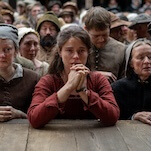The contrasts between Siberia and Under The Dome illustrate so much about genre TV that it’s tempting to imagine them being put up against each other as some sort of test of the viewing public every Monday at 10 p.m. If that were the case, the fact that Under The Dome has garnered enough viewers to warrant a second season while Siberia limps to its probable series end tonight (after a season where it was once preempted by the birth of the Royal Baby) equals a failing grade for anyone looking for truly adventurous network sci-fi or horror.
Does that mean that Siberia is a genre TV classic? Well, no. It’s got an unknown cast of variable quality, its improvisational structure means its pace often goes slack, and approximately half of the twists it throws out actually land. Even with all that, Siberia far outstrips its (much) more popular rival in any head-to-head competition. It’s not even close.
The premise used to sell Siberia to the public is by far its weakest element, as many sci-fi or horror premises are. “Fake reality show where the contestants are killed off for real” is the sort of glib “high concept” pitch that invites lazy execution. You know, like “small town is trapped under an impenetrable dome.” However, most genre fiction is born of similarly summarize-able sound bites—the difference is in what the creators do with it. And while Under The Dome has turned into an indifferent slog through under-imagined cliché and predictable characters, its big budget and (more germanely) Stephen King pedigree have won it cushy ratings (if critical shrugs), Siberia has ridden its considerable, if low-rent and decidedly scruffy goofball thrills right into a ratings nowhere its beleaguered characters would all-too assuredly recognize.
From the outset, Siberia’s premise worked against itself as far as gathering an audience. Those intrigued by the reality show angle most likely weren’t interested in deconstructing the genre, while reality show haters (like, um, me) went into it holding our noses. Others were probably just confused. At any rate, as Alasdair Wilkins’ pilot review accurately noted, Siberia’s adherence to the reality format (colorful cast of stereotypes, confessional interview segments, delineation of the rules) wasn’t especially different, or more interesting, than any actual reality show (like, say, this year’s Capture). Even in that first, exposition-heavy episode, however, the show dropped tantalizing little nuggets of ambiguity around its edges, with the rather straightforward Survivor-meets-Manor House pin-setting (no rules, gotta live off the land, last one standing gets a half million) seasoned with hints that not everyone was what they appeared, and that the chosen Russian wilderness setting (actually filmed in Manitoba) had some secrets of its own.
Oh, and there’s a big magic box. Okay, not magic per se, but certainly mysterious—a huge, monolith-like contraption that spit out a daily doodad designed to guide the contestants’ (and shows’) actions. That box looked to be the engine driving the show, dispensing sometimes treats, sometimes clues, always seemingly without outside agency. A nice, regular plot device to keep Siberia ticking along in predictable fashion.
And then the strapping Australian host revealed that one of the contestants has died in an accident, but the show would still go on. And then there was the tiger found mauled in the woods by… something. And the century old diary, and the related markings on the trees. And the green lights in the skies. And the mysterious fire, and the strange, lizard-like footprints, and the cave painting showing villagers fighting off… something, and the booby trap. And then the desiccated body that one contestant finds and doesn’t tell the others about—because it’s wearing her identical locket. And then things get really weird…
Like the magic box, Siberia dropped its puzzling new twists and turns for viewers to be confused and delighted by. And though the contestants, gradually comprehending that their experience has become something far more complicated—and dangerous—than what they signed on for, finally manage to wrench open the thing, they find only a collection of further inexplicable objects (a book, pills, vodka). And I was right there with them, grinning a goofy grin as the Siberia machine dropped twist after loopy twist in my lap and dared me to figure out where it was going.
What differentiates Siberia’s unending parade of improbabilities from Under The Dome’s? Commitment. For all its recognizable faces and bisected cows, Under The Dome has remained resolutely conventional in its approach to its supernatural dilemma—no matter how apocalyptic the Dome itself might seem, the people within it approach their shared fate with the unimaginative, incurious placidity of stock television characters. The unknowns on Siberia, aided by the Blair Witch-y immediacy of the faux reality format, actually seem to have some stake in their plight. As zombie maven George Romero stated about his human extinction scenario (specifically his Day Of The Dead), the real drama involved is “about how a lack of human communication causes chaos and collapse even in this small little pie slice of society.” The show, and creator Matthew Arnold, seem to understand that the real dramatic meat in any such scenario is the pressure it puts on people to reveal who they really are. No matter how outlandish the situation characters find themselves in, what makes the whole thing tick is how viewers see themselves in the actions of characters in the last extremity.
And that commitment has allowed a number of Siberia’s heretofore unknown cast to provide some of the most affecting stealth performances of the 2013 TV season. Quickly shedding its most boring characters (goodbye stereotypical middle aged racetrack tout I immediately dubbed “Swifty Laroux”), the show has wisely whittled down its cast to the following;
- Johnny (Johnny Wactor), the prototypical “good looking bad boy who plays by his own rules” whose initial douchiness is deconstructed to surprisingly affecting effect—his reluctantly assumed leadership role forcing him to make some wrenching decisions.
- Sabina (Sabina Akhmedova), a former Israeli soldier, she’s clearly the most capable person of the group.
- Annie (Anne-Marie Mueschke), a goth whose love for an ill-fated contestant marks her as the designated tragic figure.
- Irene (Irene Yee), her facility with a bow and arrow unfortunately sidetracked when a booby trap shunts her into victim mode.
- Neeko (Neeko Skervin), a ridiculously fit, British personal trainer whose gung-ho righteousness is routinely subverted by the fact that he’s wrong about almost everything.
- Miljan (Miljan Milosevic), a Serbian DJ whose easygoing comic relief persona gradually curdles into creepy stalker behavior, possibly due to supernatural influence (although he was pretty creepy from the outset).
- Esther (Esther Anderson), an Aussie model whose Machiavellian gamesmanship marks her as the reality show’s villain—before the shit gets real. (She’s still relatively shady afterward.)
- Sam (Sam Dobbins), the burly Brooklyn bouncer whose gruff, thuggish demeanor belies an innate nobility (and a handy ability to speak Russian).
- Daniel (Daniel Sutton), the requisite weedy geek who shows his mettle (and some Swiss army knife-style skills) as the show progresses, and who's my pick for the show’s breakout star.
While the improv-y nature of the series occasionally shows up the cast’s shortcomings, each of these actors succeeds at various times in lending their initially-stock characters with real agency and pathos. Wactor’s conflicted prettyboy gradually becomes empathetic as his assumed leadership seems to lead to tragic results. And the growing kinship between Dobbins and Sutton (especially in the scene where Sam lies seemingly dying on the tundra) is the most unexpectedly affecting TV friendship in recent memory. I know I’ll check out most of their IMDb pages to see what they’re going to do now that the show seems to be over.
As for tonight’s episode, the sheer number of hanging plot threads means that a certain amount of dissatisfaction was going to be involved—either there would be an unpalatable number of ambiguities left over or things would be over-explained into banality. As it turns out, the show simply charged ahead as if it weren’t going to be cancelled, which makes the action (commandos are involved), that much more visceral and exciting. And, as the timer ticked down and the assembled contestants/survivors made their way through an eerily abandoned city, it became clear that Siberia was going to just plain run out of time. Like that magic box, Siberia (if this is all we’re ever going to get) should be appreciated by fans of weirdness everywhere. It’s not its fault that there weren’t enough of us who wanted to find out what it’d spit out next.
Stray observations:
- Even though the show adopted the Star Trek: The Next Generation strategy of separating the interesting characters and the duller ones into groups for the last few episodes, I found myself unabashedly moved when everyone reunited at the start of tonight’s episode.
- Throughout, the show makes the traditional inconsistent nods toward the fact that there are a team of cameramen filming everyone. Sometimes it’s clever, but mostly you just have to accept that there’s just no damned reason (except that otherwise we wouldn’t be able to see what’s going on) that the cameramen would be where they are. I’m fine with it.
- The original music from Corey Wallace remains understated and effectively deployed right to the end.
- The ratings aren’t promising for another season of Siberia (and I’m not sure the concept could sustain another 11 episodes), but I’m genuinely bummed out not to see what Matthew Arnold and company would trot out week-to-week.








































